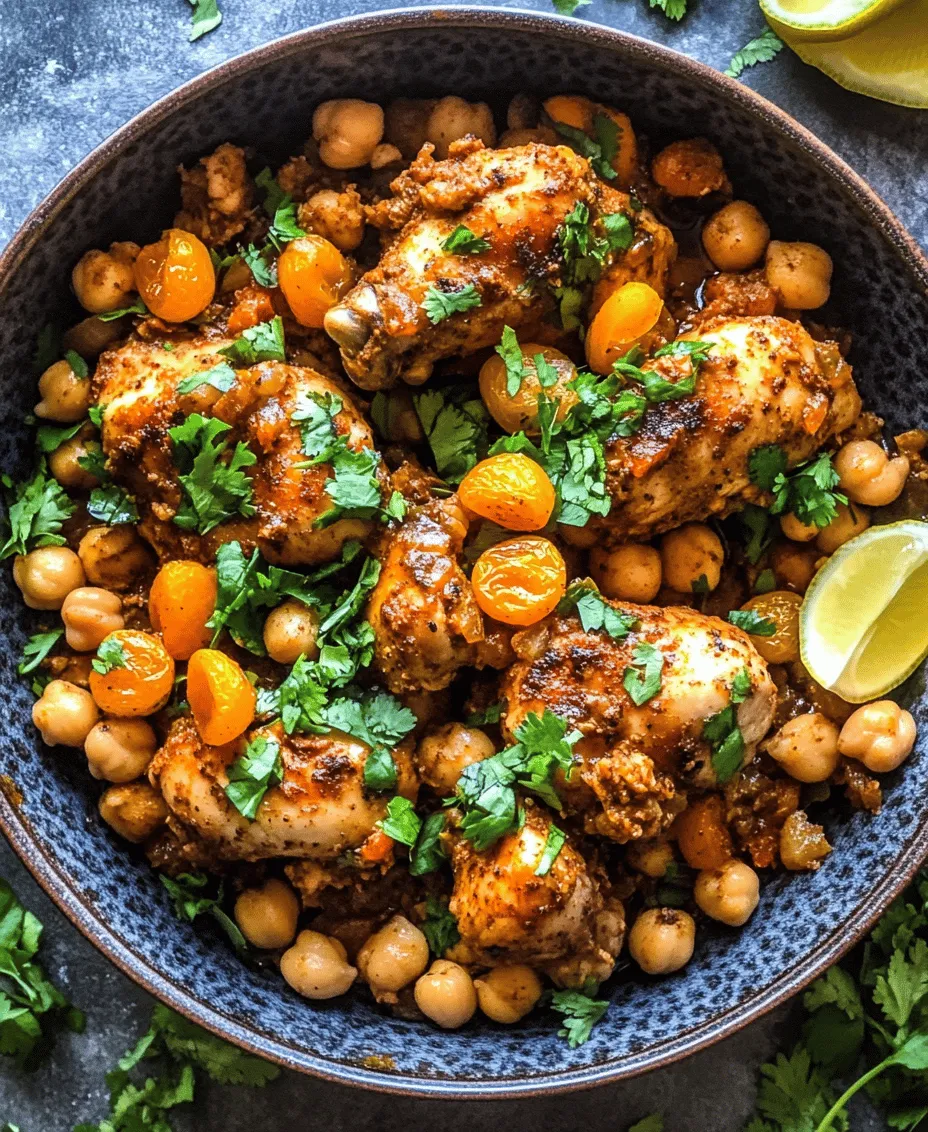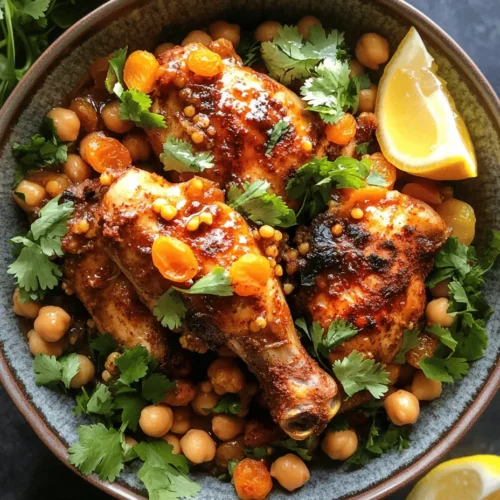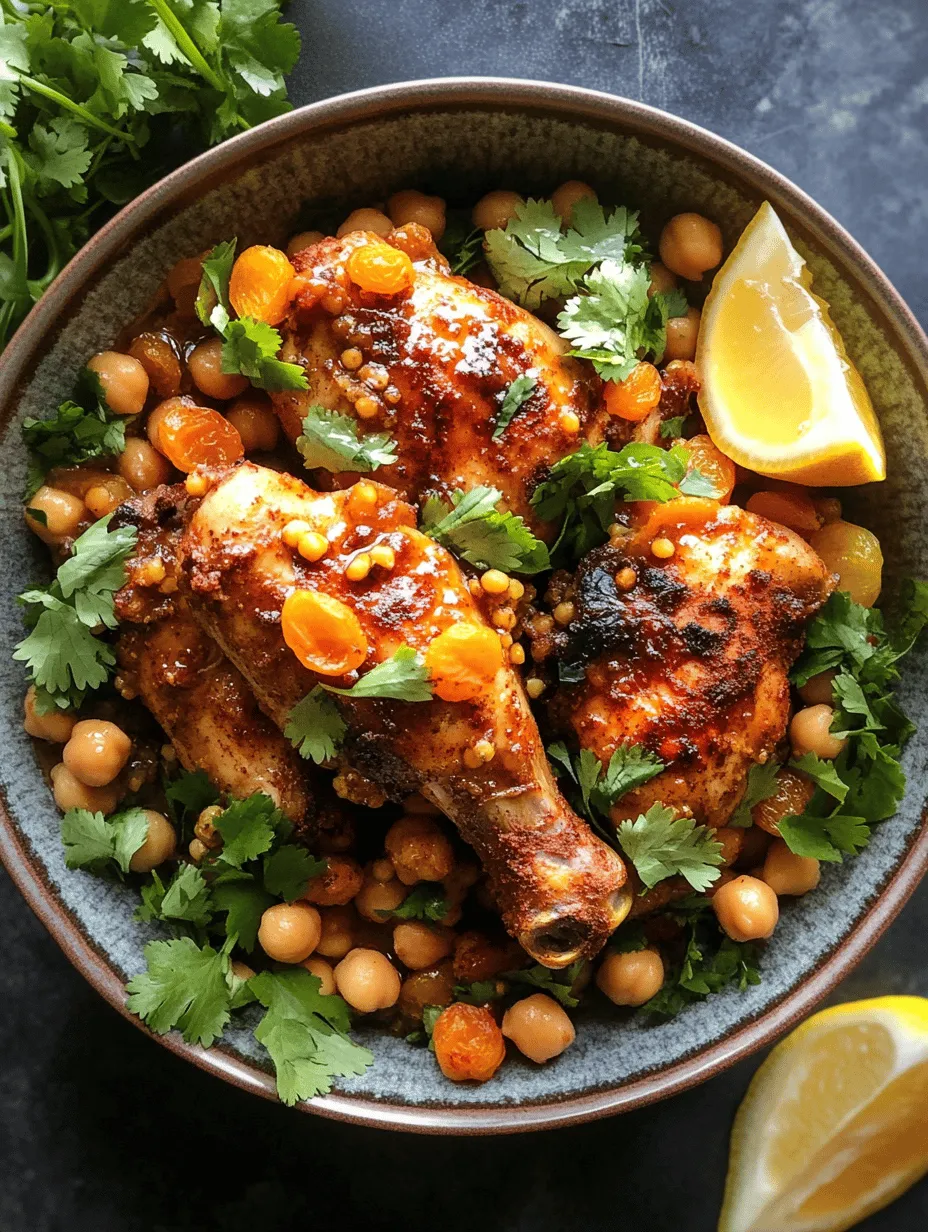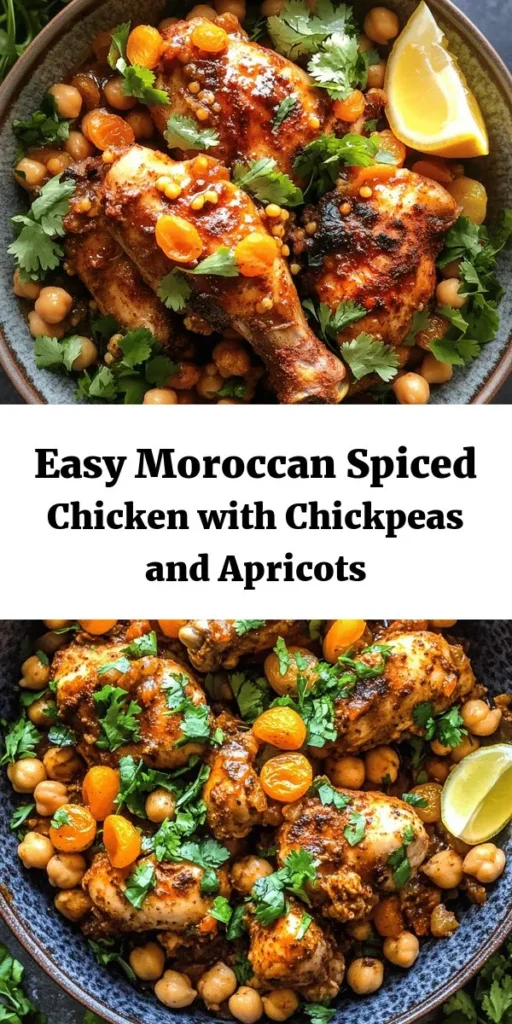Introduction
Moroccan cuisine is a vibrant tapestry of flavors, aromas, and textures that reflects the rich history and diverse geography of the North African country. Known for its bold spices and intricate culinary techniques, Moroccan food offers a sensory experience that delights the palate and entices the senses. One of the standout dishes that encapsulate this essence is Moroccan Spiced Chicken, a recipe that marries savory and sweet elements, making it an ideal choice for any occasion, from casual family dinners to festive gatherings.
This Moroccan Spiced Chicken recipe is not only flavorful but also easy to prepare, perfect for both novice cooks and seasoned chefs. The combination of aromatic spices, tender chicken, and a hint of sweetness from dried fruits creates a remarkable dish that transports you straight to the bustling markets of Marrakech. Whether served over a bed of fluffy couscous, paired with aromatic rice, or simply enjoyed on its own, this dish is sure to impress and satisfy.
Understanding Moroccan Cuisine
At the heart of Moroccan cooking lies a profound appreciation for spices. These ingredients are not merely used for flavor; they play a vital role in the culinary traditions of the region. Spices such as cumin, coriander, cinnamon, and paprika are not only integral to the taste but also bring a range of health benefits. For instance, cumin is known for its digestive properties, while cinnamon has been praised for its anti-inflammatory effects.
Traditional Moroccan ingredients are a blend of local produce, herbs, and spices, often reflecting the country’s agricultural diversity. Olive oil, for instance, is a staple in Moroccan kitchens, celebrated for its healthy fats and versatility. It serves as a base for many dishes, enhancing flavors while providing essential nutrients. The inclusion of chickpeas and dried fruits like apricots adds both texture and nutritional value, making the dishes not only delicious but also wholesome.
Culturally, Moroccan food is a reflection of the country’s history and geography. Influenced by Berber, Arab, and Mediterranean traditions, Moroccan cuisine has evolved over centuries, incorporating diverse cooking methods and ingredients. The use of tagines—traditional earthenware pots—illustrates the significance of slow-cooking techniques that allow flavors to meld beautifully. This emphasis on communal eating and sharing food mirrors the Moroccan way of life, where hospitality is paramount.
Ingredients Breakdown
Before diving into the cooking process, it’s essential to understand the ingredients that will bring this Moroccan Spiced Chicken to life.
Chicken
Boneless, Skinless Chicken Breasts: The star of this recipe, boneless, skinless chicken breasts, are perfect for quick cooking and absorbing flavors. They are lean and nutritious, making them a healthier option compared to darker cuts. If you prefer, you can also use chicken thighs for a richer flavor and juicier texture.
Olive Oil
Olive Oil: This healthy fat not only enhances the dish’s flavor but also provides essential monounsaturated fats. It aids in the absorption of fat-soluble vitamins and has been linked to numerous health benefits, including heart health.
Spices
Ground Cumin: Known for its warm, earthy flavor, cumin is a staple in Moroccan cuisine. It aids digestion and is rich in antioxidants, making it a nutritious addition to your meals.
Ground Coriander: This spice adds a citrusy note to dishes. Coriander is known for its potential to lower blood sugar levels and improve heart health.
Ground Cinnamon: Often associated with sweetness, cinnamon also imparts a warm flavor profile to savory dishes. It has numerous health benefits, including anti-inflammatory properties and improved insulin sensitivity.
Smoked Paprika: This spice adds depth and a subtle smokiness to the chicken. Smoked paprika is often used in Moroccan recipes to enhance the overall flavor.
Cayenne Pepper: For those who enjoy a bit of heat, cayenne pepper can be adjusted according to personal preference. It also offers metabolic benefits and is known to promote digestion.
Ground Ginger: Ginger adds a zesty kick and is well-known for its digestive benefits. It can also help reduce inflammation and boost the immune system.
Additional Ingredients
– Chicken Broth: This adds moisture and enhances the flavor of the chicken during cooking.
– Chickpeas: A great source of protein and fiber, chickpeas add heartiness to the dish.
– Dried Apricots: These provide a touch of sweetness and a chewy texture, balancing the savory spices beautifully.
– Honey: A drizzle of honey can enhance the sweetness further, creating a harmonious blend of flavors.
– Cilantro: This fresh herb adds brightness and a burst of flavor, perfect for garnishing.
– Lemon Wedges: A squeeze of lemon juice at the end adds acidity and brightness to the dish.
Discussion on Ingredient Sourcing
When preparing Moroccan Spiced Chicken, sourcing authentic ingredients can elevate your cooking experience. Local spice shops or specialty markets often carry a variety of spices that can enhance the dish’s authenticity. If you’re unable to find specific spices, many can be substituted with more common alternatives, although the flavor may differ slightly. For example, if you cannot find smoked paprika, regular paprika with a touch of cumin can work in a pinch.
Step-by-Step Cooking Instructions
Marinating the Chicken
One of the most critical steps in preparing Moroccan Spiced Chicken is marinating the chicken. This process allows the flavors to penetrate the meat fully, resulting in a dish that is rich and savory.
1. Prepare the Marinade: In a large bowl, combine olive oil, ground cumin, ground coriander, ground cinnamon, smoked paprika, cayenne pepper, and ground ginger. Adjust the cayenne pepper according to your preferred heat level. Add a generous pinch of salt and freshly ground black pepper to taste. Mix well to create a fragrant paste.
2. Marinate the Chicken: Add the boneless, skinless chicken breasts to the marinade, ensuring each piece is thoroughly coated. Cover the bowl with plastic wrap or transfer the chicken to a resealable plastic bag. For optimal flavor, marinate the chicken in the refrigerator for at least 1 hour, or up to overnight if time allows.
3. Tips for Best Results: If you’re short on time, a minimum of 30 minutes will still impart good flavor, but longer marination will yield the best results. Remember to bring the chicken to room temperature before cooking to ensure even cooking.
Searing the Chicken
Once the chicken is marinated, it’s time to sear it. Searing not only creates a beautiful golden crust but also locks in moisture, enhancing the overall taste of the dish.
1. Heat the Pan: In a large skillet or Dutch oven, heat a couple of tablespoons of olive oil over medium-high heat. Ensure the oil is hot but not smoking before adding the chicken.
2. Cook in Batches: If you’re using a large amount of chicken, consider cooking it in batches to avoid overcrowding the pan. Overcrowding can trap steam and prevent the chicken from achieving a perfect sear.
3. Sear the Chicken: Place the marinated chicken breasts in the hot skillet, searing them for about 5-7 minutes on each side, or until a golden-brown crust forms. Use tongs to flip the chicken gently to avoid tearing.
4. Check for Doneness: The chicken is cooked through when it reaches an internal temperature of 165°F (75°C). Use a meat thermometer to ensure accuracy. Once done, remove the chicken from the skillet and set it aside to rest while you prepare the sauce.
5. Building the Sauce: After searing, you can deglaze the pan with chicken broth, scraping up any brown bits stuck to the bottom. This adds depth of flavor to the dish.
With these steps completed, you’re well on your way to enjoying a delightful Moroccan Spiced Chicken that embodies the essence of Moroccan cuisine. As you continue with the cooking process, you will find that the combination of spices, herbs, and ingredients creates a dish that not only satisfies hunger but also brings joy to the dining experience. Stay tuned for further instructions that will guide you through the finishing touches and serve suggestions for this aromatic dish.

Preparing the Aromatics
To elevate your Moroccan Spiced Chicken, the first step is to prepare your aromatics. Aromatics play a crucial role in building the foundational flavors of any dish, especially in Moroccan cuisine where spices and ingredients come together to create a rich tapestry of tastes.
Onions and garlic are the backbone of this flavor development. Begin by finely chopping one large onion and mincing three cloves of garlic. The onions should be translucent, which typically takes about 5 to 7 minutes of sautéing over medium heat. This process allows the natural sugars in the onion to caramelize slightly, enhancing their sweetness and complexity.
Timing is essential when sautéing these aromatics. If you cook them for too long, they can become bitter rather than sweet. Aim for a golden-brown color without letting them burn. Once your onions are softened and fragrant, add the minced garlic. Garlic cooks much faster than onions—about 30 seconds to 1 minute is sufficient. This timing ensures that the garlic retains its pungent flavor without turning acrid.
Building the Flavor Base
With your aromatics ready, it’s time to build the flavor base for your Moroccan Spiced Chicken. In a large, heavy-bottomed pot or Dutch oven, add a couple of tablespoons of olive oil and heat it over medium-high heat. Once the oil shimmers, introduce your chicken pieces, seasoned with salt and pepper, and let them sear for about 5 minutes on each side until browned. This step is crucial as it locks in the chicken’s juices and creates a beautiful crust.
Now, return to your sautéed aromatics and add them to the pot along with spices such as ground cumin, coriander, cinnamon, turmeric, and paprika. Stir these spices into the mixture, allowing them to toast for a minute or two. The heat will release their essential oils, creating an aromatic blend that will coat the chicken and permeate the dish with Moroccan flavors. This stirring and coating process is vital; it allows the spices to stick to the chicken, ensuring that every bite is infused with flavor.
Simmering to Perfection
After building your flavor base, it’s time to add the liquid components to create a nice sauce. Pour in a cup of chicken stock, followed by a can of drained chickpeas and a handful of chopped dried apricots. The chickpeas add a delightful texture while the apricots introduce a subtle sweetness that balances the spices.
Bring the mixture to a gentle simmer, then cover the pot with a lid. This is where patience pays off. Let your chicken simmer on low heat for about 30 to 40 minutes. This slow cooking process ensures the chicken becomes tender and absorbs all the delicious flavors.
To check for doneness, use a meat thermometer to ensure the internal temperature of the chicken reaches at least 165°F (75°C). Alternatively, you can cut into a piece of chicken to see if the juices run clear. If they are still pink, allow the chicken to cook for a few more minutes.
Serving Suggestions
To serve your Moroccan Spiced Chicken, presentation is key. Consider plating the chicken with a generous ladle of the aromatic sauce over a bed of fluffy couscous, allowing the grains to soak up the flavorful juices. Garnish with fresh cilantro or parsley for a pop of color.
For side dishes, classic accompaniments include a vibrant green salad dressed with a lemon vinaigrette, or crusty bread for dipping into the luscious sauce. The bread is particularly delightful for soaking up every last drop of the flavorful broth.
Flavor Profile and Pairing Suggestions
The flavor profile of Moroccan Spiced Chicken is a beautiful balance between savory and sweet. The warmth of the spices melds seamlessly with the sweetness of the apricots and the earthiness of the chickpeas, creating a dish that is both comforting and exciting.
For beverage pairings, consider a fruity red wine like a Grenache or a light-bodied Pinot Noir, which will complement the spices without overpowering them. If you prefer non-alcoholic options, a spiced apple cider or even a refreshing mint lemonade works wonderfully to contrast the richness of the chicken.
Alternative side dishes that can enhance your meal experience include roasted seasonal vegetables, which add a lovely caramelized flavor, or a yogurt sauce with fresh herbs that can cut through the richness of the dish.
Nutritional Information
When it comes to nutritional value, this Moroccan Spiced Chicken is not only delicious but also packed with beneficial nutrients. Each serving contains approximately 350 calories, with around 30 grams of protein, making it a satisfying meal option.
Key ingredients offer various health benefits:
– Chicken: A lean protein source that helps in muscle building and repair.
– Chickpeas: High in fiber and protein, they aid digestion and help maintain steady blood sugar levels.
– Dried apricots: Rich in vitamins A and C, they also provide potassium and iron, contributing to overall health.
Cultural Significance and Personal Touch
Moroccan cuisine is steeped in rich history and culture, often seen as a representation of the country’s diverse influences, including Berber, Arab, and Mediterranean traditions. Cooking in Moroccan culture is not just about nourishment; it’s about hospitality and sharing. Meals are often enjoyed with family and friends, fostering connections and creating lasting memories.
Reflecting on my own experiences with Moroccan cooking, I recall evenings spent in the kitchen with my family, preparing tagines and savoring the aromas that filled our home. It’s a tradition that encourages exploration and creativity, inviting everyone to embrace different culinary traditions while celebrating the bonds that meals create.
Conclusion
In summary, Moroccan Spiced Chicken is a dish that showcases the vibrant flavors and cultural richness of Moroccan cuisine. From the preparation of the aromatics to the careful building of flavors and the delightful serving suggestions, every step contributes to a meal that is both satisfying and memorable.
I encourage you to try this recipe and dive deeper into Moroccan cuisine. It’s a wonderful way to explore new flavors, connect with loved ones, and create lasting memories around the dinner table. Remember, cooking is not just about the food; it’s about the love and joy that comes from sharing it with others. Embrace the magic of Moroccan cooking, and let it inspire your culinary journey.



